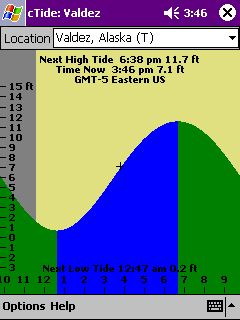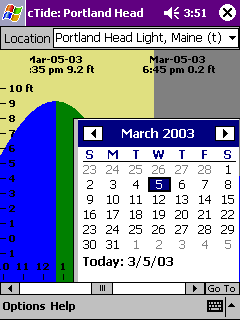
 |
|
||
cTide: tide prediction software for PocketPC's
Suggested Reading: What is
cTide? |
|
cTide is graphical tide prediction software for PocketPC's and Palm-sized PC's. cTide provides tide and current predictions for about 5,900 locations around the world. Data can be displayed in a few different graphical views. Predictions can be performed on any date between 1970 and 2038. This program uses the harmonic method to display tide levels either as a tide clock (showing the current level) or as a graph. All of the data and constants are read in from the harmonics file.
This program is postcard-request free software. Source code is included. If you like the software, please send me a postcard. The address is listed in the program under Help About cTide.
Read the online help file for more information on things like, what if my location is not listed, and getting new data.
The tide prediction algorithm used in this program was developed with United States Government funding, so no proprietary rights can be attached to it. For more information, see the reference information.
2 things, some features and some bug fixes. The new
features are:
+ Allow any storage location for harmonics data files (flash
cards or other folders).
+ Missing or moved harmonic index brings up navigator UI to hunt
down and choose new location.
+ Color chooser on PocketPC's for setting UI colors (rising,
falling, day, night, etc.).
+ Faster startup if you use local locations files (also much
smaller storage usage).
+ New Pocket PC 2002 specific binary.
Bugs fixed:
+ Changed display code to not re-paint screen all the dang
time
+ Fixed round off error for locations based on GMT offsets using
1/2 hour increment (e.g. GMT -8.5)
+ Fixed PocketPC 2002 mangling of time zone name.
+ Fixed moon phase display glitch.
+ Fixed several preferences saving issues.
+ Fixed several preference settings.
+ Fixed embarrasing language localization issue with location of
programs and data files.
+ Fixed management/saving of locations in dropdown
list.
This program is NOT FOR NAVIGATION. There are many other products and tools in the world designed for that purpose. This program is distributed in the hope that it will be useful, but WITHOUT ANY WARRANTY; without even the implied warranty of MERCHANTABILITY or FITNESS FOR A PARTICULAR PURPOSE. Please read the GNU General Public License for more details.
Here are 2 screen shots of cTide. The first is the
"normal" graph view, where the display is updated every minute to
reflect the current tide (or current) for the chosen location.
The second is a "scrolling" graph mode, where you can pick
arbitrary dates in time to show predictions for. This display
does not update. So in this example, you can check the tide on
tax day to see when you might want to go fishing.


You will need the following in order to use this program (these are max values, with new micro-locations, your mileage will vary):
This program was created from WXTide32 written by Michael Hopper. His program was created from the original work of David Flater, who created XTide. David's site has lots of good information about tide predictions and the whole process. Please check it out. He also has a nice FAQ for the clueless at: http://www.flaterco.com/xtide/faq.html
Once you have ActiveSync installed on your PC, installation is pretty simple, though there are now 2 steps. Step 1 download the cTide installer (see the link below), then run that program. This will install the cTide program on your PocketPC (or Palm-sized PC). If you want to uninstall cTide from your device, choose Remove Programs from your control panel and select "Airtaxi Software cTide" and choose remove. Step 2 download one of the location (harmonics) data installers and run that program. Ditto the previous uninstall.
Step 1
Download ctidesetup.exe here (1.01MB).
Step 2
Choose the "All Location" installer or browse for a
regional "micro-location":
A. Download all locations ctidedatafull.exe
here (.92MB).
B. Or browse for and choose a local (and much smaller)
data set here (download the ctidedata.exe file): Browse For A
Location
New locations have been updated. The new locations are:
Caroline Islands, England, Fiji Islands, Germany, Northern
Ireland, Northwest Territories, Scotland and Wales. Also are some
new compilations for the US that cover multi-state regions. They
are:
NEAtl: Quebec, Ontario, New Brunswick, New Foundland, New
Hampshire, Rhode Island, Connecticut, New York and
Massachussetts.
CEUS: D.C., Virginia, Delaware, Maryland, Pennsylvania, N
& S Carolina, New York & New Jersey
SEUS: South Carolina, Georgia, Alabama, and Florida.
CSUS: Florida, Mississippi, Louisiana and Texas.
SWUS: California and Oregon.
PacNW: Oregon, Washington, British Columbia and
Alaska.
By default the files you need to run cTide are installed on your device under \Program Files\ctide. Additionally the help file is placed in the \windows folder.
The Windows Installer will place the cTide files
into your local Windows CE ActiveSync folder, which on *my* PC
is:
C:\Program Files\Microsoft ActiveSync\cTide
Device Files: ctide.exe The Windows CE program (device/OS version specific) ctide.htm On-line help file gpl.txt General Public License (please read, IT IS IMPORTANT) PC Files: readme.txt The readme file gpl.txt General Public License (please read, IT IS IMPORTANT) cTide.ini The .ini file for cTide used by CE Application Manager cTide.211MIPS.cab Data files and binary for CE v2.11 for MIPS devices cTide.211SH3.cab cTide binary for CE v2.11 for SH3 devices cTide.3xARM.cab cTide binary for CE v3.0 for ARM devices cTide.3xMIPS.cab cTide binary for CE v3.0 for MIPS devices cTide.3xSH3.cab cTide binary for CE v3.0 for SH3 devices cTide.2002.cab cTide binary for PocketPC 2002 devices cTidesrc.zip Source code for cTide, harm2idx & EzSetup uninst.exe Uninstaller program to remove PC files
If you have comments, bugs, feedback, etc. please email me: Note that I no longer have my P.O. Box so don't worry about the postcards. Send me an email with a picture if you like. I will find a way to post them here.
In a word, fish. I like to saltwater flyfish. I don't have a boat, so I fish from land. The best fishing usually takes place with fish actually being where you are. This may seem wise-ass, but stand on the edge of the ocean with your tiny fishing rod when no fish are around, and all of sudden you feel a lot smaller than when you showed up. The fish often feed and move with the tides. River mouths, inlets, jetty's, etc. all tend see more action when the tide is moving.
Thanks to Mike Hopper for the WXTide32 starting point. Thanks to David Flater for a few pointers on how to upgrade to the most recent xtide harmonics files (and for the original xtide). Also thanks to many friends who put up with me bothering them about this over the *long* period it took me to finish it off and release it (Ahad, Mike, Jerry and many others). Thanks to the Nullsoft 'ware pimps for NSIS, a much easier way for me to create all the installers. Thanks to James Clark for the nifty XML parser (Expat). Thanks to Bert Bos for the UTF-8 to ASCII snippet. For editing/handling of larger files (like the data files) I use notGNU version 1.93. Thanks Julie. :)
Manual of Harmonic Analysis and Prediction of Tides. Special Publication No. 98, Revised (1940) Edition (reprinted 1958 with corrections; reprinted again 1994). United States Government Printing Office, 1994.
Computer Applications to Tides in the National Ocean Survey. Supplement to Manual of Harmonic Analysis and Prediction of Tides (Special Publication No. 98). National Ocean Service, National Oceanic and Atmospheric Administration, U.S. Department of Commerce, January 1982.
These publications can be obtained from the National Oceanic & Atmospheric Administration (NOAA).
For a more brief overview of the history of tidal analysis and prediction the NOAA has a nice set of pages at The Center for Operational Oceanographic Products and Services.
All Content and Images are Copyright ©2006 Airtaxi Software. All rights reserved.